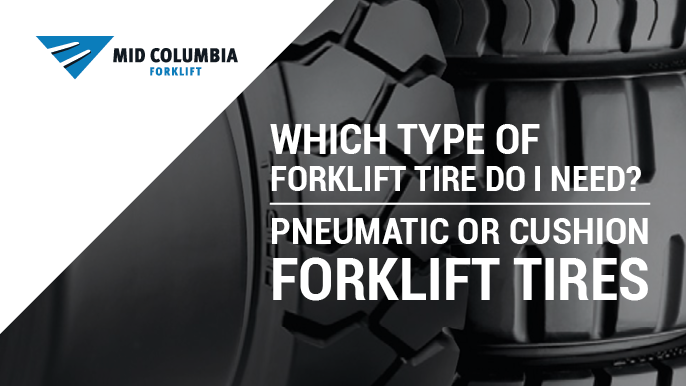Which Type of Forklift Tire Do I Need? Pneumatic or Cushion Forklift Tires
by , on February 21, 2020 at 9:00 AM

Forklifts primarily have two different types of tires: cushion tires and pneumatic tires. While there may be some different types, they fall under those two main umbrellas. What type of tires your forklift uses depends primarily on your working environment. Selecting the right type of forklift tire configuration is essential for success and your workspace safety.
Pneumatic Forklift Tires
Pneumatic forklift tires are similar to those you find on a standard car or truck and offer versatile performance. The tread of a pneumatic forklift tire provides a strong grip for uneven surfaces outdoors such as dirt or gravel.
This versatility makes pneumatic tires the right fit for:
- Lumberyards
- gravel lots
- some warehouses with outdoor sections
- and more
Typically, pneumatic tires compensate for uneven ground by absorbing some of the shock to provide a smoother ride for operators. Solid pneumatic and foam-filled pneumatic tire options are also available to help reduce the risk of puncture and low air pressure.
Cushion Forklift Tires
Cushion forklift tires are designed specifically for use in indoor warehouses and some loading docks. These smooth rubber tires are attached to a metal band and are easier to maintain and replace than pneumatic tires. While they do offer less traction than pneumatics, they help reduce wear and tear on warehouse floors and keep the ride smooth for operators. Cushion tire options are perfect for close-quarters maneuvering needed in the tight spaces of modern warehouses, thanks to the tight turn radiuses they enable.
Forklift Tire Tips
Forklift tires require regular attention, just like your car or truck. Keep these three tips in mind to help maximize your tire and forklift lifespan:
- Remember, forklifts are typically designed for one type of tire only. You cannot replace a pneumatic tire with a cushion tire - this requires purchasing a replacement forklift that supports this configuration.
- Perform regular checks of your forklift tires for signs of damage. Cracking, chunking, and tearing are signs of damage that require replacement to prevent accidents.
- Problem signs in your tires can also indicate issues in your workspace. Unusual chunks and tears may point to problems in your warehouse floor that need your attention.
Need help identifying the right tire configuration for your workplace? The talented forklift professionals at Mid-Columbia Forklift and MidCo Material Handling are ready to help you determine what configuration is right for your business. Contact us today to learn how we can help improve your business performance from top to bottom.
Further Reading
Signs It’s Time to Change Your Forklift Tires
Top Ways to Reduce Downtime in Your Warehouse
Most Commonly Replaced Forklift Parts





